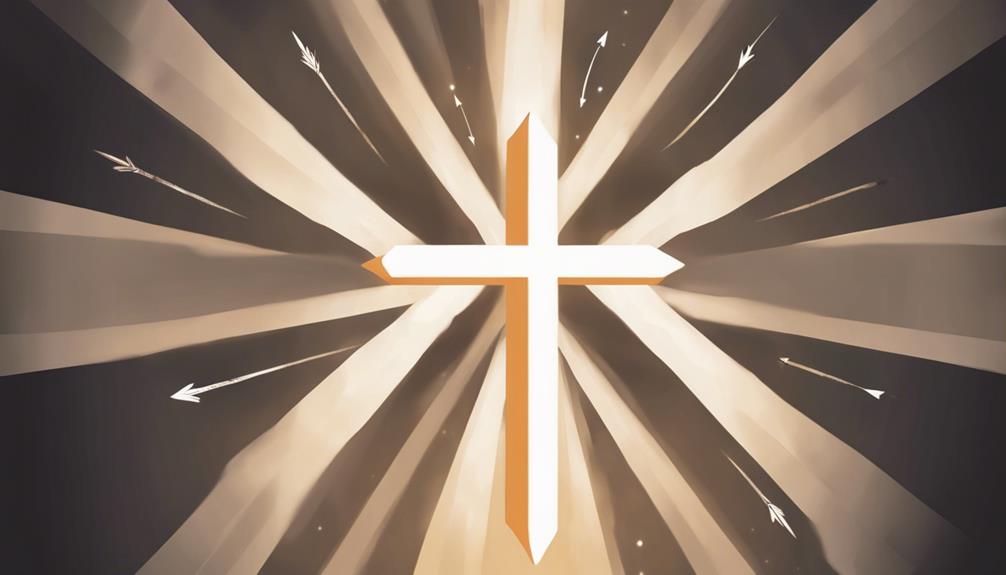Learn how arrows in the Bible symbolize more than just warfare, uncovering deep spiritual meanings that illuminate ancient divine messages.

Arrows in the Bible
In the vast ocean of biblical symbolism, arrows stand out like towering lighthouses, guiding ships through the murky waters of interpretation. You might not have considered how these ancient weapons transcend their literal existence, embodying concepts of divine punishment, protection, and even blessings.
As you explore the nuanced roles arrows play, from instruments of God's will to symbols of fertility, you'll uncover layers of meaning that could reshape your understanding of biblical narratives. The question now is, how will these insights influence your perception of the divine messages woven through scripture?
Key Takeaways
- Arrows symbolize divine intervention, protection, and punishment, reflecting God's active engagement in human affairs.
- They represent the precision and swiftness of God's will and justice in biblical narratives.
- As symbols of blessings and fertility, arrows indicate prosperity and the continuation of lineage.
- Arrows teach contemporary lessons on adaptability, direction, and the importance of community strength.
Symbolism of Arrows

In biblical texts, arrows often symbolize divine intervention, judgment, and protection, illustrating a multifaceted representation within a religious context. You'll notice that arrow metaphors permeate scripture, weaving a complex tapestry of meanings that transcend mere historical or literal interpretations. These metaphors, deeply embedded in the culture and language of the times, serve as a bridge, connecting the divine with the human, the spiritual with the material.
Warfare imagery, including arrows, is prevalent in the Bible, symbolizing not only physical conflict but also spiritual battles. This imagery portrays the struggles between good and evil, right and wrong, often with arrows standing as symbols of God's will being enacted in the world. You're drawn into a narrative where arrows aren't just weapons but instruments of divine will, pointing beyond their physicality to deeper, spiritual truths.
Through these metaphors, the Bible communicates complex theological ideas in an accessible manner. It's a testament to the enduring power of these symbols that they continue to resonate, offering insights into the nature of divine intervention and the human condition.
Divine Punishment and Protection
Throughout the Bible, arrows serve as stark symbols of divine punishment and protection, directly reflecting the complex relationship between human actions and divine response. You'll find that these instances aren't just arbitrary; they're deeply intertwined with historical accuracy and the warfare tactics of the time. This blend of divine symbolism and real-world strategy offers a nuanced understanding of how the biblical authors viewed God's intervention in human affairs.
When arrows are depicted as instruments of divine punishment, it's often in the context of retribution against sin or disobedience. This isn't merely about the physical destruction that arrows can cause; it's a metaphorical representation of the consequences of straying from God's path. The precision of an arrow strike parallels the targeted nature of divine justice, emphasizing that none can escape the repercussions of their actions without repentance.
Conversely, when arrows symbolize divine protection, they illustrate God's power to shield and save those who remain faithful. This protective aspect isn't just a passive barrier; it's an active engagement in the struggles faced by believers, showcasing God's willingness to intervene directly in human conflicts. The historical accuracy of these descriptions reinforces the credibility of divine protection, grounding it in the reality of ancient warfare tactics.
Arrows as God's Will

Arrows, as depicted in biblical narratives, often embody God's will, acting as both messengers and executors of divine intention in human history. These arrow metaphors serve as powerful illustrations of how divine intervention can shape the course of events, emphasizing the warfare parallels that exist between spiritual battles and earthly conflicts.
In examining the role of arrows within the Scriptures, it's crucial to consider:
- The precision of arrows symbolizes the targeted nature of God's actions, ensuring they accomplish exactly what He intends.
- The speed at which arrows travel reflects the swift and sometimes unexpected implementation of God's will in human affairs.
- Arrows as instruments of warfare draw a parallel to the spiritual battles believers face, highlighting the importance of divine guidance and protection.
- The launching of an arrow signifies the initiation of God's will, a moment where divine purpose is set into motion towards its intended target.
This analysis reveals that arrows aren't merely weapons in a physical sense but are imbued with theological significance, representing God's active presence and intervention in the world. Through these warfare parallels, believers are reminded of the strength and precision of God's will in their lives.
Blessings and Fertility
Beyond their martial significance, arrows also symbolize blessings and fertility in biblical contexts, serving as metaphors for prosperity and the continuation of lineage. This imagery is not merely decorative but deeply rooted in the agricultural society of biblical times, where harvest imagery and genealogical growth were paramount indicators of divine favor.
Aspect |
Biblical Reference |
Symbolic Meaning |
|---|---|---|
Arrows |
Psalms 127:4-5 |
Children, heritage |
Quiver |
Genesis 27:3 |
Preparedness, bounty |
Target |
Jeremiah 50:9 |
Precision, fulfillment |
In these texts, arrows are not instruments of war but of blessing, indicative of a family's prosperity through the abundance of offspring. The quiver, filled with arrows, illustrates preparedness and the capacity for bounty, reinforcing the idea of an ample harvest, both in terms of crops and children. The target, often associated with God's will in other contexts, here aligns with the precision and fulfillment of one's lineage and the broader community's genealogical growth.
This rich tapestry of symbolism underscores the Bible's nuanced approach to common elements, transforming them into profound conveyors of spiritual and material prosperity.
Contemporary Lessons

Reflecting on the symbolic significance of arrows as blessings and fertility in biblical times, it's crucial to explore how these ancient metaphors offer insightful lessons for modern spiritual and societal growth. The imagery of arrows, deeply rooted in ancient warfare and cultural contexts, extends beyond historical artifacts to impart contemporary wisdom.
- Adaptability and Strategy: Just as arrows were pivotal in ancient warfare, adapting strategies to life's challenges is essential. This teaches the importance of flexibility and planning in achieving personal and communal goals.
- Growth and Direction: Arrows symbolize direction and force. They remind you to set clear goals and pursue them with determination, embodying the growth and fertility aspects highlighted in biblical narratives.
- Protection and Defense: In biblical times, arrows were tools for protection. This underscores the value of safeguarding spiritual beliefs and cultural values in today's rapidly changing world.
- Unity and Strength: The effectiveness of arrows in ancient conflicts often depended on the unity and coordination of the archers. This symbolizes the strength found in community and collective action, resonating deeply within both spiritual and societal contexts.
Frequently Asked Questions
How Were Arrows Actually Made and Used in the Times Described in the Bible?
You're looking into how arrows were crafted and utilized in ancient times.
Arrow materials often included wood for the shaft, with stone or metal tips for piercing.
Fletching techniques, involving the addition of feathers to the tail, improved the arrow's flight stability.
These methods reflect a sophisticated understanding of materials and aerodynamics, showcasing early advancements in technology and warfare.
Such insights reveal the intricate craftsmanship behind these seemingly simple tools.
Are There Any Specific Stories or Parables Where Arrows Played a Crucial yet Often Overlooked Role?
You're diving into an era where arrow symbolism and archery skills weren't just old-school tactics but pivotal elements of storytelling.
Specifically, arrows in certain narratives aren't just background props; they're central to understanding deeper meanings.
These stories, rich with metaphor and history, reveal how arrow symbolism intertwines with faith and fate.
Analyzing these tales, you'll uncover the nuanced roles arrows played, often missed at a casual glance.
How Do Different Translations of the Bible Vary in Their Depiction and Interpretation of Arrows?
When you explore translation methodologies, you'll find they greatly influence the depiction and interpretation of texts. Cultural interpretations further diversify these readings, making the meaning of specific elements, like arrows, vary across translations.
It's crucial to analyze how translators' backgrounds and the cultural context they're embedded in shape their approach. This analytical, scholarly exploration helps you understand the layered meanings behind seemingly straightforward references in various translations.
Can You Provide Details on Any Archaeological Findings That Support the Existence and Use of Arrows During Biblical Times?
As the saying goes, 'where there's smoke, there's fire,' archaeology often unearths truths from the past.
You'll find that arrowheads, discovered in ancient Near Eastern sites, validate the existence and use of arrows.
These artifacts, coupled with depictions on ancient walls, offer a glimpse into arrow symbolism and archery techniques of the era.
Such findings provide a scholarly context, grounding our understanding of historical narratives in tangible evidence.
How Have Arrows in Biblical Contexts Influenced Art, Literature, and Culture Outside of Religious Texts?
Arrows have deeply influenced art, literature, and culture, embodying themes of direction, force, and protection. Modern interpretations often draw on these ancient symbols, enriching narratives with layers of meaning.
Arrow symbolism, extending beyond their physical representation, invites a nuanced exploration of human experiences and beliefs. Their presence in diverse mediums showcases the enduring legacy of these symbols, highlighting their ability to convey complex ideas across various cultural landscapes.
Conclusion
In the tapestry of biblical narratives, arrows aren't merely weapons of war; they're divine symbols, weaving stories of punishment, protection, and providence. Imagine them as shafts of light, piercing through the darkness to guide or chastise. They're God's will made manifest, arrows that can bless with fertility or strike with judgment.
In today's context, these ancient symbols challenge us to reflect on the direction and force of our actions, urging a thoughtful navigation through life's moral and spiritual battlegrounds.



Sign up